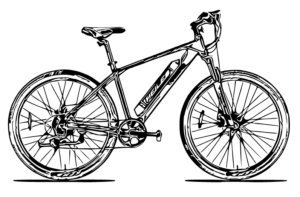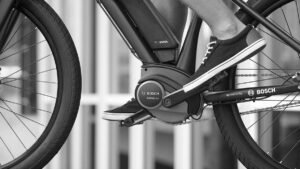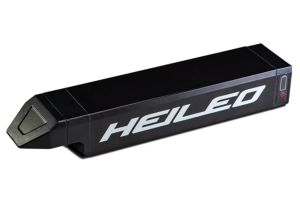Decoding Electric Cycles

Electric Cycles (also known as eBikes) have been around for over a decade now. However, they have found increased adoption during and post pandemic times, around the world. To many, electric cycle is a new concept and the world around us is also learning. In this blog, Raghu Kerakatty, CEO and Founder of Toutche, tries to explain the functional parts of an Electric Cycle, and what prospective buyers (and current users) should look to evaluate, when buying one.

An electric cycle/bike or eBike, is a regular bike with the addition of an electric drivetrain to make it easier to ride, so you can go further and faster than on a regular cycle. As long as the Electric Cycles doesn’t use the motor to assist it above 25kmh (15.5mph) and the motor itself has a power rating of 250 Watts or less, it is regarded as a regular bicycle when in use on public roads in many countries.
There are several different terms for electric cycles or eBikes you might hear – Pedelecs, EAPCs (Electrically Assisted Pedal Cycles) and ‘Twist and Gos’ – but in the end they are just other names for eBikes, the different names highlighting different ways in which eBikes – mechanically speaking – can work. Pedelecs mean the motor power is activated by turning the pedals whilst ‘twist and gos’ are simply cycles with a throttle that can work independently of other power controls. EAPC is simply government or legal speak for an electric cycle (electric cycles are regulated slightly differently in different countries).
They are becoming more and more popular as more and more people are recognising the benefits, they can bring for the rider – cheap, practical transport that also has great green credentials and is also a fun and healthy activity.
How do you ride Electric Cycles and What can you use them for?
If you can ride a regular (non-electric) bicycle you should be able to ride an electric cycle. It requires the same skills of balance and control, the difference being the small electric motor onboard makes it easier to pick up speed and to get up and over hills. And of course, you can go for longer distances on an electric cycle without getting tired and you can get to places faster and without breaking a sweat.
Commuting to work remains one of the main uses of electric cycles of course; you can easily avoid traffic jams on two wheels and a reliable electric cycle means you get to work reliably on time. You also avoid the regular costs of public transport or running a car. For this kind of use a reliable electric cycle with enough battery capacity to get you where you need to go are the main criteria; a stylish design and higher performance characteristics are perhaps of secondary importance.
If you are riding an electric cycle for leisure, the quality and look of the machine itself may be more important to you. Other criteria might well be important too; something reasonably lightweight with a lively motor and plenty of battery capacity will be more fun on longer rides. A trail or mountain style electric cycle might suit your needs if you want to venture off-road where wider, knobbly tyres and a suspension fork will provide comfort and safety on longer rides. Features like disk brakes and a more sophisticated handlebar display will make mean leisure rides are more enjoyable and fun.
Electric cycle in their modern form have been around at least a couple of decades and so have had time to evolve and manufacturers have had time not only to produce better motors and batteries but also a very wide range of different electric cycle designs. The choice of modern electric cycle models is quite amazing, encompassing lightweight road racing models, folding eBikes and much larger electric cargo bikes that can take huge loads and even transport people around. In other words, whatever you would like to be able to do on an electric cycle it’s quite likely there will be a design to accomplish it.
What to look for when buying an Electric Cycle?
The important components an electric cycle, a prospective or current user will be well served to understand, are –
• Frame
• Weight
• Motor
• Battery
• Bike Control Unit (or Controller)
• Display Console
• Pedal Assist Sensors
• Brake Sensors
• Mechanical components
Let’s understand each of them a bit more in detail.
Frame
An electric cycle is a cycle first and foremost. Like any cycle, the type of the frame is a key factor to understand. The difference between frames in a regular cycle and an electric cycle, is that an electric cycle frame needs to be engineered to accommodate a battery (1.5 to 3Kgs depending on the size and type of battery) and a motor (2 to 3Kgs depending on the size and type of battery). The most used materials for frame-making are –
• Carbon fibre | Lightest, advanced tube shapes, expensive
• Aluminium Alloy | Light, advanced tube shapes, cheaper than carbon fibre
• Steel | Heavier, limited tube shapes, can corrode if not treated well, cheaper than others
Weight
Like regular cycles, electric cycles are designed for specific purposes – commuting, off-roading, folding, cargo, comfort etc. The weight of an electric bicycle can hence vary across different styles. Generally, most electric bikes weigh between 18 to 30Kgs. The main contributors to the weight of an electric bike are –
• Frame type and material – Lean profile with no suspension v/s bulkier profile with suspension; made of Carbon fibre, Aluminium alloy, or Steel
• Battery size – the capacity of the battery and the type of cells used
• Motor – mid motor eBikes tend to be heavier than hub motor eBikes
Motors
There are two main groups of electric motors in use on e-bikes; hub motors and mid-drives (also sometimes called crank drives or motors).
Hub motors
The kind you are most likely to come across are hub motors, which as the name suggests are placed in the bicycle wheel hub. The motor can be placed in the front or rear hub, but most e-bike manufacturers will opt for a rear hub; this means the bike is a little better balanced for handling and the wheel less prone to wheelspin when most power is going through the motor (front wheel hub motors can be prone to this).
By contrast ‘kits’ are sold that customers can retrofit to existing non-electric bikes and these are often front wheel hubs for the simple reason that these are usually much simpler to fit and are compatible with a larger number of bike designs.
You might also hear hub motors described as ‘geared’ or ‘gearless’ (gearless motors also being referred to as being direct drive), though it is a distinction that can be applied to every e-bike motor. It has nothing to do with the gears on the bike which are there to make pedalling comfortable and effective.
A geared motor is one where the power from the turning parts of the motor passes through the motor’s own internal gears to drive the bike. In gearless motors the turning parts directly drive the bike. Geared motors are much commoner as they are lighter and more efficient for the purpose of powering an e-bike. Gearless motors are larger and heavier than geared ones and are used when a near silent motor is important and also when you want the motor to act as a brake and recharge the battery (though this in itself is a very inefficient process on a small vehicle like an e-bike and in reality only recharges the battery very slowly and will not prevent the need to charge using the e-bike’s charger from another electricity source).
Mid-drive motor
These are usually easy to spot as you can see the motor around the pedal axle area as the motor acts via the chainwheel and chain to drive the bike. They are common in countries like Germany, Netherlands and Belgium where many people cycle on a daily basis and are willing to spend considerable sums of money on e-bikes.

They are more efficient than hub drives and give superb power delivery across the entire assisted speed range but are often heavier than hub motors and certainly considerably more expensive, not least because major multi-national companies like Bosch, Shimano and Yamaha have invested considerably in advancing and producing leading examples of mid-drive technology.
Of course, the motor needs electrical power, so let’s look at how an e-bike gets it, in the form of battery power.
Battery
Early electric cycle batteries were lead-acid technology, very much limiting the appeal. Its successor has been batteries based on lithium chemistry, that have come to dominate electric bicycles over the last decade and are now found on virtually every reasonable quality electric cycle.

Being several times more power dense than lead acid predecessors they have had the double virtues of lowering electric cycle’s weight and increasing battery range. Along with ever lighter and more powerful motors, lightweight lithium batteries have transformed electric cycles over the last decade. Once solely the province of those happy with heavy duty, utilitarian looking machines, electric cycles have since spread across the globe and become not only appealing to more riders but also lifestyle statements in the process.
The capacity of a Lithium-ion battery is measured in Watt hours (Wh) and is calculated as Ampere hour (Ah) x Voltage (V). Anything less than 300Wh (8.3AH/36V) is considered a small battery, 300-400Wh (8.3-11.1Ah/36V) would be mid-size and over 400Wh (11.1Ah+/36V) is a large battery.
Larger batteries don’t just give more miles/kms per charge, but you are also more likely to get a longer life since it will need recharging less often and hence the battery cells will deteriorate more slowly. The battery cells are the most important aspect and good quality batteries are likely to be made of cells from good quality manufacturers like Panasonic or Samsung. If looked after properly, good quality batteries should last several years. A battery is the most expensive part of an eBike. Therefore, it is key to research these aspects of the battery well when looking to buy an eBike.
Bike Control Unit (BCU)
Commonly called the controller, it is usually a hidden element of the e-bike, tucked away in the frame or battery housing, and are often described as the ‘brain’ of the e-bike. It performs the critical function of collecting input signals from the battery, display, motor, pedals, throttle, brakes and wheels and delivers the right, optimised amount of power to the motor at the right time. The firmware (programme) on the BCU is built to protect the motor and battery from the damaging effects of excessive electrical currents and voltage – hence making it crucial to have the right BCU for that spec of electric cycle. An efficient BCU ensures the optimised power delivery, lesser impact on the motor and battery and the bike is nicer to ride.
Display Console
Along with the presence of a motor and battery, handlebar controls are another visible sign that a bike is electrically assisted. At the very least there will be a power control button to turn the bike on and to switch between different levels of power assist – lower power settings mean longer battery range but of course will require a little more human input to maintain the same speed.
You may or may not see a display screen – they are not absolutely necessary to make an electric cycle work but can provide useful info, not least on whether you are shortly to run out of battery power. They can display everything from basic information such as bike speed and remaining battery capacity to all manner of advanced data and can add functions to the electric cycle by linking to third party devices such as a smartphone or heart rate monitor.
Pedal Assist Sensors (PAS)
Electric Cycles are generally equipped with either a Cadence or Torque sensor. Cadence and torque sensors communicate to the Bike Control Unit (BCU) when to engage the motor and propel the bike forward. They both help drive the electric bicycle forward with varying degrees of pedalling effort. However, the difference lies in how they work.
Cadence-based PAS engage the motor when a rider begins to pedal. The amount of power delivered to the motor depends on the pedalling effort of the rider and the selected pedal assist level. At every set power assist level, as the rider’s pedalling speed (their cadence) increases beyond a threshold, the BCU will reduce the motor’s power output and increase the motor’s power output rider’s pedalling speed decreases below a threshold. Cadence sensor-based, electric cycles require relatively light pressure on the pedals to activate the motor. This makes them a great option for riders who are looking for an effortless way to ride.
Torque based PAS determines the amount of power the motor should deliver based on the force, applied on the pedals. Torque sensors drive the increase or decrease in the motor’s output in real time, in unison with the amount of force the rider applies on the pedals. The harder you pedal, the motor provides more power output, up to the pre-set limit for a given PAS level and the less intense you pedal, the motor syncs up with you and deliver lesser power. With electric cycles on torque sensors, riders feel more intuitive the motor’s level of assistance is matching the pedalling efforts. Riders don’t experience a sudden bout of power when changing PAS levels because power is decreased/increased gradually and dynamically.
Torque sensor-based PAS is commonly found in mid-drive electric cycles which tend to be more expensive. The hub-motor electric cycles commonly use cadence sensors.
Non-Electric Parts
Non-electric components also play a critical part in your ride experience. Features that you may be better served to look closely at, are –
• Gears (front and/or rear, number of gears, quality of gears used, freewheel v/s cassette)
• Shifters
• Derailleurs
• Suspension (spring v/s hydraulic, travel distance, with or without lock-out)
• Disk brakes (mechanical or hydraulic)
• Rims (single or double walled)
The type and quality of components used, add up to the overall quality of your electric cycle. They also show how much brands are investing on performance, safety, and endurance at the forefront of their design.
How much should one spend on an Electric Cycle?
The key elements that determine the price and riding experience of an electric cycle are – Battery, Motor and Specs of the mechanical components. There is a range of electric cycles available in the market, at various price points. How much you should pay depends entirely on what your needs are, and wallet can afford. By spending a little more, one is always more likely to get an electric cycle that will be more fun and enjoyable to ride, perform better and last longer. Should the budget be tighter, there are many budget range bikes that come with a lower spec, lower range, and life, but will do the job for you. The capacity of a lithium-ion battery is more likely to be on a pricier electric cycle. The Bike Control Unit on a good quality e-bike is more likely to be well integrated with the motor and battery.
Like with any new product category, it helps to research all aspects thoroughly, compare multiple brands and choose one that delivers the best value for your need and wallet.
Do visit – https://toutche.com/



